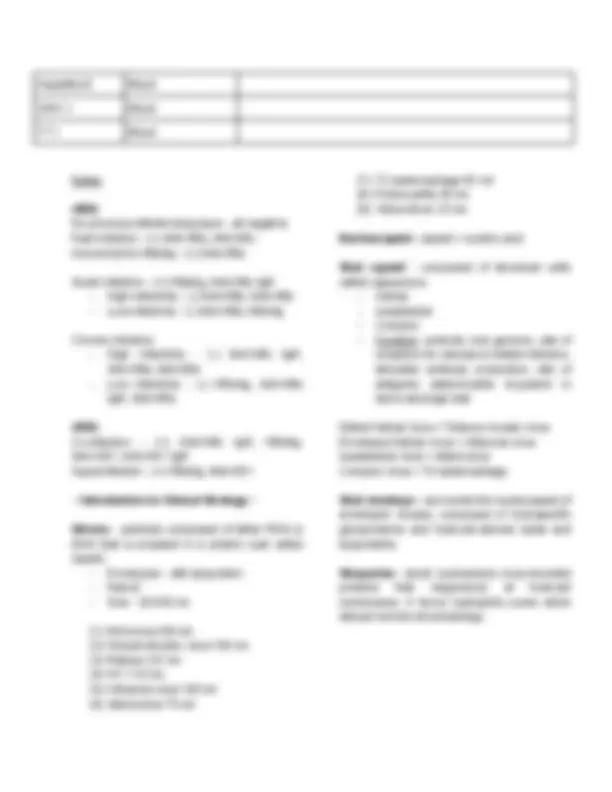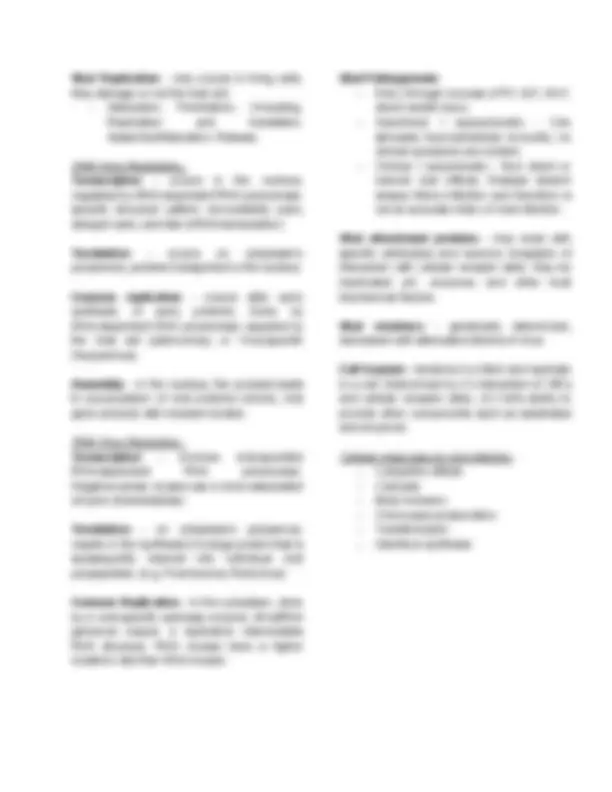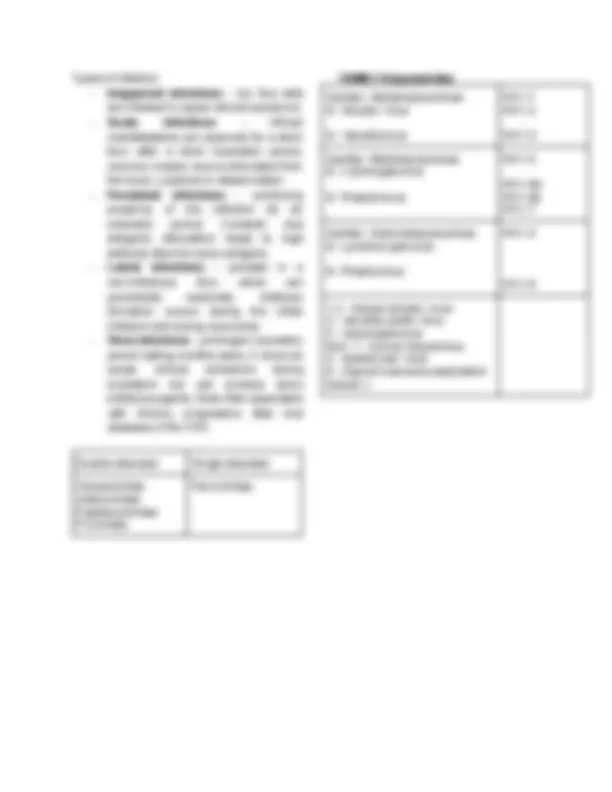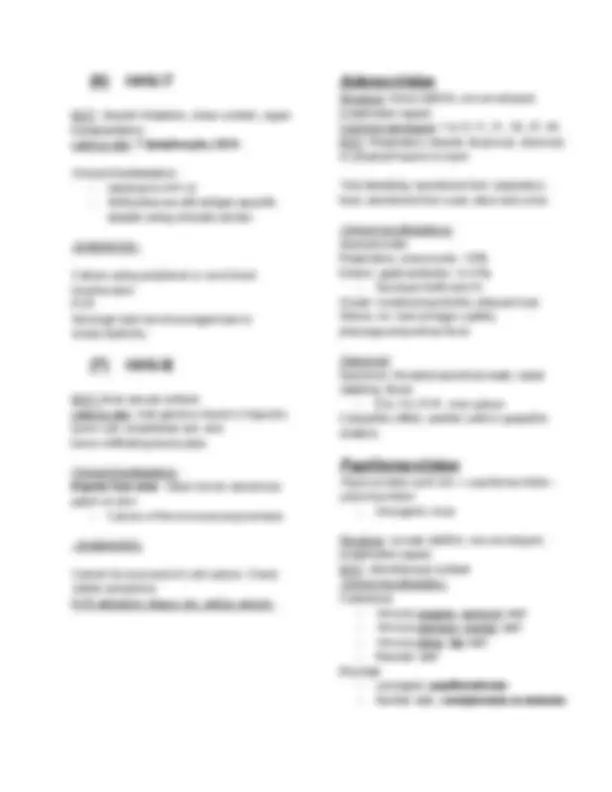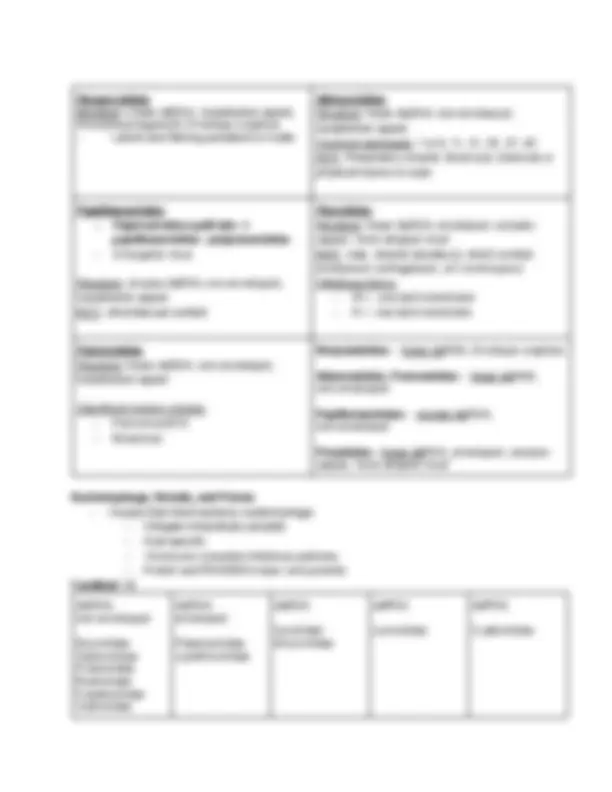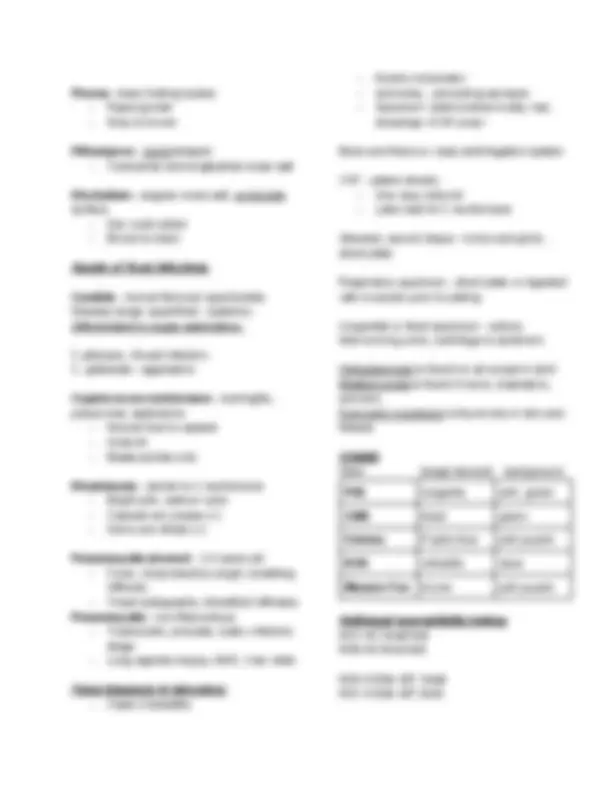Download Overview of Hepatitis Viruses and Herpesviridae and more Study notes Microbiology in PDF only on Docsity!
Hepatitis A Vaccine available F. Picornaviridae, G. Hepatovirus Affects only humans and primates Stable = high temp, low pH Does not cause chronic liver damage, Low mortality rate, no persistence. Acute self-limiting hepatitis. 90% in children <5yo, asymptomatic. Mild - severe prolonged hepatitis, in adults. If exposed to HAV: give immune globulin. -Lab- Serology, HAV IgM Ab (diff. to culture) Hepatitis B Vaccine available F. Hepadnaviridae, Circular dsDNA Enveloped Icosahedral capsid HBV virions, dane particles Uses reverse transcriptase, DNA product from mRNA Infects liver cells, immune mediated destruction Elevated serum transferases, sometimes jaundice 90% resolution without serious sequelae 10% become chronic carriers, high risk for cirrhosis and hepatic carcinoma Incubation : 2-6mos -Lab- Serologic markers
- HBsAg
- Anti-HBs
- Anti-HBc
- HBeAg
- Anti-HBe Hepatitis C Vaccine available F. Flaviviridae G. Hepacivirus Most frequent NANBH infection 90%, non-A/non-B hepatitis Capable of reinfection Acute hepatitis, less severe than HBV 50% chronic in infected patients 20% of chronic carries = cirrhosis within 20-30y, cirrhosis leads to liver cancer -Lab- Anti-HCV, does not produce lifelong antibodies, persistence indicates chronic infection ELISA screening test RIBA (western blot) Hepatitis D Vaccine available F. unassigned G. Deltavirus Circular ssRNA HBV-dependent envelope HDV ribozymes
- Gives RNA capability to self cleave. Defective virus that requires HBV for replication Simultaneous infection with HBV, poses greater likelihood of a more severe acute infection progressing to fulminant hepatitis. Superinfection : infection in chronic HBV carrier -Lab- Serology, Anti-HDV
Hepatitis E F. Hepeviridae G. Hepevirus Linear ssRNA (+) sense Non-enveloped Icosahedral capsid Infection similar to HAV, but has a higher fatality rate in pregnants. Acute, self-limiting “Dark urine” Incubation : 2-9w -Lab- ELISA, HEV IgG and IgM Hepatitis G F. Flaviviridae G. Pegivirus/GB virus Similar to HCV, genetically distinct -Lab- Anti-HGV, HGV RNA by PCR SEN-V F. Circoviridae Circular ssDNA Non-enveloped Icosahedral capsid Possible link to hepatitis TTV F. Anelloviridae Circular ssDNA Non-enveloped Icosahedral capsid Associated with post-transfusion hepatitis. Hepatitis Viruses
- HAV
- HBV - not an RNA virus
- HCV
- HDV
- HEV
- HGV
- SEN-V - not an RNA virus
- TTV - not an RNA virus All have tropism to the liver. Clinical findings are not a basis of viral identification. MOT: Fecal-oral route (HAV,HEV) Blood (HBV,HCV, HDV, HGV, SEN, TTV) Hepatitis A Fecal-Oral route Sexual/Household contact, daycare contact, foodborne, waterborne, IV drug use, international travel Hepatitis B Blood Needle Sexual contact IV drug use, MenxMen, household contacts, Tatts and piercings, healthcare personnel, neonatal infection Hepatitis C Blood Sexual contact Blood exposure, usually transfusion, sometimes sexual contact, IV drug use. Hepatitis D Blood Sexual contact IV drug use, population endemic for HBV Hepatitis E Fecal-Oral route
Viral Replication - only occurs in living cells. May damage or not the host cell.
- Adsorption, Penetration, Uncoating, Replication and translation, Assembly/Maturation, Release. DNA Virus Replication_ Transcription - occurs in the nucleus, regulated by DNA-dependent RNA polymerase; specific temporal pattern (immediately early, delayed early, and late mRNA transcription) Translation - occurs on cytoplasmic polysomes, proteins transported to the nucleus. Genome replication - occurs after early synthesis of early proteins. Done by DNA-dependent DNA polymerase, supplied by the host cell (adenovirus), or Virus-specific (herpesvirus). Assembly - in the nucleus, the process leads to accumulation of viral proteins (virions, viral gene product) with inclusion bodies. RNA Virus Replication_ Transcription - involves viral-specified RNA-dependent RNA polymerase. Negative-sense viruses use a virion-associated enzyme (transcriptase). Translation - on cytoplasmic polysomes, results in the synthesis of a large protein that is subsequently cleaved into individual viral polypeptides. (e.g. Picornavirus, Retrovirus) Genome Replication - in the cytoplasm, done by a viral-specific replicase enzyme. All ssRNA genomes require a replicative intermediate RNA structure; RNA viruses have a higher mutation rate than DNA viruses. Viral Pathogenesis
- Entry through mucosa of RT, GIT, GUT, direct needle injury
- Subclinical / asymptomatic : Can stimulate humoral/cellular immunity, no clinical symptoms are evident.
- Clinical / symptomatic : from direct or indirect viral effects. Disease doesn't always follow infection and therefore is not an accurate index of viral infection. Viral attachment proteins - may react with specific antibodies and become incapable of interaction with cellular receptor sites. May be inactivated pH, enzymes, and other host biochemical factors. Viral virulence - genetically determined, decreased with attenuated strains of virus. Cell tropism - tendency to infect and replicate in a cell. Determined by (1) Interaction of VAPs and cellular receptor sites, (2) Cell’s ability to provide other components such as substrates and enzymes. Cellular responses to viral infection:
- Cytopathic effects
- Cytolysis
- Body inclusion
- Chromosomal aberration
- Transformation
- Interferon synthesis
Types of Infection:
- Inapparent infections - too few cells are infected to cause clinical symptoms.
- Acute infections - clinical manifestations are observed for a short time after a short incubation period, recovery means virus is eliminated from the body. Localized or disseminated.
- Persistent infections - continuing presence of the infection for an extended period. Constant viral antigenic stimulation leads to high antibody titers for some antigens.
- Latent infections - persists in a non-infectious form which can periodically reactivate. Antibody formation occurs during the initial infection and during recurrence.
- Slow infections - prolonged incubation period lasting months-years, It does not cause clinical symptoms during incubation but can produce some infectious agents. Most often associated with chronic, progressive, fatal viral diseases of the CNS. Double stranded SIngle stranded Herpesviridae Adenoviridae Papillomaviridae Poxviridae Parvoviridae FAMILY Herpesviridae Subfam. Alphaherpesvirinae G. Simplex Virus G. Varicellovirus
HHV-
HHV-
HHV-
Subfam. Betaherpesvirinae G. Cytomegalovirus G. Roseolovirus
HHV-
HHV-6a HHV-6b HHV- Subfam. Gammaherpesvirinae G. Lymphocryptovirus G. Rhadnovirus
HHV-
HHV-
1,2 - herpes simplex virus 3 - varicella-zoster virus 5 - cytomegalovirus 6a,b, 7 - human herpesvirus 4 - epstein-barr virus 8 - Kaposi’s sarcoma-associated herpes v.
-DIAGNOSIS-
Specimen: urine, body fluids, tissues, buffy coat Cytopathic effect: Owl eye !, indicating CMV infections of a lung pneumocyte Other tests. P65 Ag detection (wbc), Diploid fibroblast cell line culture, PCR, branched DNA, hybridization.
(3) Epstein-Barr Virus
MOT: saliva, “kissing disease” Latency site: B lymphocytes Clinical Manifestation:
- Infectious mononucleosis
- Burkitt’s lymphoma, Hodgkin disease
- Nasopharyngeal carcinoma -DIAGNOSIS- Culture is not usually available, and needs B cells. PBS: atypical lymphocytes Paul-Bunnell heterophile antibody test Serologic test:
- Anti-VCA: viral capsid antigen
- Anti-EA IgG: early antigen
- Anti-EA/D: early antigen, diffuse
- Anti-EA/R: early antigen, rough
- Anti-EBNA: epstein-barr nuclear antigen All negative = no previous exposure. (-) Anti-EBNA = ac. infectious mononucleosis All positive = recent infection (+) Anti-VCA-IgG, Anti-EBNA = past infection
(4) Varicellovirus
MOT: droplet inhalation, contact with infectious lesions. Latency site: dorsal root ganglia Clinical Manifestation: Primary: chickenpox/varicella Reactivation: shingles/zoster Varicella Zoster Mild febrile illness, rash, vesicular lesions Vesicles - “dew drop on a rose petal” Dry, crust over in 1- wks Travels down infected nerves, band pattern Very painful Postherpetic neuralgia -DIAGNOSIS- Specimen: lesion (vesicle) Viral culture 3-7d, DFAs Prevention: vaccine
(5) HHV-
MOT: droplet inhalation, close contact, organ transplantation. Latency site: T lymphocyte, CD4+ Clinical Manifestation:
- Roseola, roseola infantum, exanthem subitum, or sixth disease
- Mostly asymptomatic/mild
- Infection by saliva, 6mos-2y
- Fever with maculopapular rash as fever subsides
- Reactivation significant in immunocompromised. -DIAGNOSIS- Culture not routinely done, lymphocytes needed. Serology:
- IgM detected 5d after infection
- IgG detected several days later than IgM PCR
(6) HHV-
MOT: droplet inhalation, close contact, organ transplantation. Latency site: T lymphocyte, CD4+ Clinical Manifestation:
- Identical to HHV-
- Antibodies are still antigen-specific despite being clinically similar. -DIAGNOSIS- Culture using peripheral or cord blood lymphocytes PCR Serologic test not encouraged due to cross-reactivity.
(7) HHV-
MOT: likely sexual contact Latency site: viral genome found in Kaposi’s tumor cell, endothelial cell, and tumor-infiltrating leukocytes. Clinical Manifestation: Kaposi Sarcoma - black brown cancerous patch on skin
- Cancer of the immunocompromised.
- DIAGNOSIS- Cannot be recovered in cell culture. Check visible symptoms. PCR detection. tissue, bm, saliva, semen.
Adenoviridae
Structure: linear dsDNA, non-enveloped, icosahedral capsid Common serotypes: 1 to 8, 11, 21, 35, 37, 40 MOT: Respiratory droplet, fecal-oral, chemical or physical trauma to eyes Viral shedding: secretions from respiratory tract, secretions from eyes, stool and urine. Clinical manifestations; Asymptomatic Respiratory: pneumonia ~10% Enteric: gastroenteritis ~5-15%
- Serotype Ad40 and 41 Ocular: keratoconjunctivitis, shipyard eye Others. Ac. hemorrhagic cystitis, pharyngoconjunctival fever Diagnosis ; Specimen: throat/conjunctival swab, nasal washing, feces
- EIA, FA, PCR, viral culture Cytopathic effect, swollen cells in grapelike clusters.
Papillomaviridae
Papovaviridea split into -> papillomaviridae - polyomaviridae
- Oncogenic virus Structure: circular dsDNA, non-enveloped, icosahedral capsid MOT: direct/sexual contact Clinical manifestation; Cutaneous
- Verruca vulgaris, common wart
- Verruca plantaris, plantar wart
- Verruca plana, flat wart
- Macular wart Mucosal
- Laryngeal, papillomatosis
- Genital wart, condylomata acuminata
Herpesviridae structure; Linear dsDNA, Icosahedral capsid, Amorphous tegument, Envelope w spikes
- Latent and lifelong persistent in hosts Adenoviridae Structure: linear dsDNA, non-enveloped, icosahedral capsid Common serotypes: 1 to 8, 11, 21, 35, 37, 40 MOT: Respiratory droplet, fecal-oral, chemical or physical trauma to eyes Papillomaviridae - Papovaviridea split into -> papillomaviridae - polyomaviridae
- Oncogenic virus Structure: circular dsDNA, non-enveloped, icosahedral capsid MOT: direct/sexual contact Poxviridae Structure: linear dsDNA, enveloped, complex capsid, “brick-shaped virus” MOT: resp. droplet (smallpox), direct contact (molluscum contagiosum, orf, monkeypox) Infectious forms.
- MV - one lipid membrane
- EV - two lipid membrane Parvoviridae Structure: linear dsDNA, non-enveloped, icosahedral capsid Significant human viruses;
- Parvovirus B
- Bocavirus Herpesviridae - linear dsDNA, Envelope w spikes Adenoviridae , Parvoviridae - linear dsDNA, non-enveloped Papillomaviridae - circular dsDNA, non-enveloped Poxviridae - linear dsDNA, enveloped, complex capsid, “brick-shaped virus” Bacteriophage, Viroids, and Prions
- Viruses that infect bacteria, bacteriophage.
- Obligate intracellular parasite
- Host specific
- Virions are complete infectious particles
- Protein and RNA/DNA major components Families! < dsDNA, non-enveloped Myoviridae Siphoviridae Podoviridae Rudiviridae Fuselloviridae Tectiviridae dsDNA, enveloped Plasmaviridae Lipothrixviridae ssDNA Inoviridae Microviridae ssRNA Leviviridae dsRNA Cystoviridae
Corticoviridae Morphologic classes (1) Polyhedral phages (2) Filamentous phages (3) Complex phages Polyhedral Circular dsDNA: PM- ssDNA: 0X174, M- Linear ssRNA: MS2, QB 3pcs. of dsRNA: 06 Filamentous Surrounds a circular ssDNA Do not cause cell lysis Via host sex pili F1 and M- Complex Linear dsDNA, protein tail, other appendages T and lambda phages of E.coli Genetic classes (1) RNA - specific for bacteria wt male pili; most are ssRNA except for 06 (2) DNA - a) virulent, via lytic. b) temperate, via lytic and lysogenic Replication
- Lytic, cell lysis and death of cell.
- Lysogenic, dna incorporation as prophage.
LYTIC CYCLE STAGES
- Adsorption
- Penetration
- Transcription, Translation
- Assembly
- Release LYSOGENIC CYCLE STAGES
- Induction/excision of prophage
- Lysogenic phage conversion - bacteria phenotype change.
- From non-toxin to toxin producing Viroids - autonomously replicating pathogens, non coding circular ssRNA
- Rely on host protein Prions - proteinaceous/infectious
- No detectable nucleic acids
- Nuclease resistant
- Protease susceptible
- TRANSMISSIBLE SPONGIFORM ENCEPHALOPATHIES
- “Mad cow disease” ; variant Creutzfeldt-Jakob disease
- Kuru - “shivering” “trembling” - Neural tissue transmission
- 1M sodium hydroxide
- 20,000 ppm chloride
- Survives formalin fixation MYCOSES (cont’d) Cunninghamella - large globose columella.
- Disseminated disease, sinus and organ
- No encasement, tiny hairlike denticle
- White to gray with age.
Phoma - black fruiting bodies
- Rapid grower
- Gray to brown Pithomyces - barrel -shaped
- Transverse and longitudinal cross wall Ulocladium - angular cross wall, echinulate surface.
- Dar, multi celled
- Brown to black Agents of Yeast Infections Candida - normal flora but opportunists. Disease range: superficial - systemic; differentiated by sugar assimilation. C.albicans - thrush infection. C. glabarata - aggressive Cryptococcus neoformans - meningitis, pneumonia, septicemia
- Mucoid due to capsule
- Inida ink
- Blastoconidia only Rhodotorula - similar to C.neoformans
- Bright pink, salmon color
- Capsule are urease (+)
- Some are nitrate (+) Pneumocystis jirovecii - 2-4 years old
- Fever, nonproductive cough, breathing difficulty
- Chest radiographs, interstitial infiltrates Pneumocystis - non-filamentous
- Trophozoite, precysts, cystic, infective stage
- Lung aspirate biopsy, GMS, Calc white Fungi diagnosis in laboratory
- Class 2 biosafety
- Electric incinerator
- screw-top , preventing aerosols
- Specimen: antimicrobial media, hair, scrapings Bone and Marrow - lysis centrifugation system CSF - plated directly
- One drop india ink
- Latex test for C.neoformans Abscess, wound, tissue - mince and grind, direct plate Respiratory specimen - direct plate or digested with mucolytic prior to plating Urogenital or fecal specimen - culture, first-morning urine, centrifuge to sediment. Histoplasmosis is found on all except in skin! Blastomycosis is found in bone, respiratory, and skin. Eumycotic mycetoma is found only in skin and tissues STAINS Stain fungal element background PAS magenta pink, green GMS black green Giemsa Purple blue pink-purple KOH refractile clear Masson-Fon brown pink-purple Antifungal susceptibility testing M27-A3 Yeast test M38-A2 Mold test M44-A Disk diff. Yeast M51-A Disk diff. Mold

